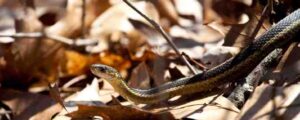The breezes are brisk, the temperatures are dropping, the leaves are changing – this could mean only one thing; that is, that the fall season is upon us.
When the weather turns mild, people often find themselves outdoors more often. Cookouts, early morning fishing trips, outdoor tidying for the upcoming colder months, gathering around the fire, and other types of outdoor activities are common and extremely enjoyable this time of year.
As you already know, there is always the risk of encountering wildlife when engaging in outdoor activities. Some of these animals may be dangerous while others are not.
However, it’s important to note that when you find yourself embarking in one of the many outdoor activities that you may enjoy this season, one of the animals that fall under the dangerous category is even more of a threat this time of year. Snakes, known to be more active and aggressive during the fall, can be an even greater danger to people who enjoy the outdoors
Breeding is the main culprit behind increased snake activity and aggression. Make snakes are working hard to win the attention of female snakes.
Female snakes are laying eggs, waiting for those eggs to hatch, and protecting their young. When young snakes emerge from their shells, they are introduced to a whole new world where predators abound. As a result, they are more aggressive.
Additionally, snakes are preparing for the cold months. They engage in brumation. This is where the metabolism slows in the body so that they are able to survive in cold temperatures.
Just like humans, they have to prepare for the upcoming harsh environmental conditions. As a result of all of these activities, you are likely to see snakes more often and find that they exhibit less than favorable personality traits.
On the most part, ALL snakes experience higher levels of aggression and activity during the fall months. However, you are more likely to see certain types than others.
These include black racers, brown snakes, copperheads, corals, garters, king snakes, rat snakes, and water moccasins – especially in the southern states.
Now that you know that it is important to avoid the hustle and bustle of snakes during the fall months, it is important to know how to avoid experiencing a dangerous direct encounter with these potentially dangerous creatures. Simply follow the steps outlined below:
If you observe a snake or multiple snakes, it may be best that you opt for professional snake removal services. For more information, contact us today by calling: 855-465-1088